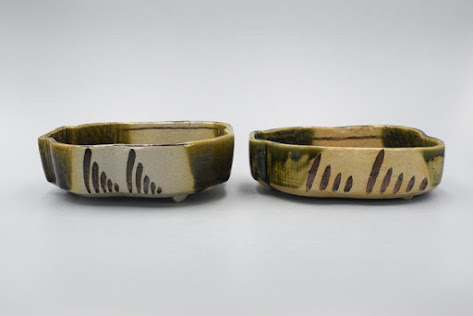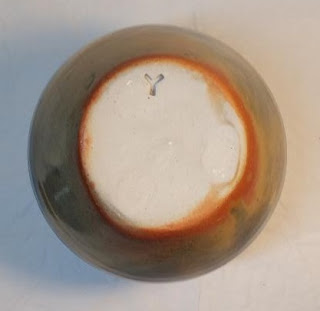109. Pair of Oribe gourd-shaped footed serving dishes
Larger (on left in
pictures). Gray clay, green and brown
glazes; most of base left unglazed. Weight: 352 g (12.5 oz). Dimensions of
rim: 15.7 x 13.3 cm (6-1/4 x 5-1/4 in).
Height (overall): 4.7 cm (1-7/8 in), height of walls: 4.2 cm (1-5/8 in).
Smaller (on
right in pictures). Yellow clay, green
and brown glazes; most of base left unglazed. Weight: 348 g (12.5 oz).
Dimensions of rim: 15.7 x 12.6 cm (6-1/4 x 5 in). Height (overall): 4.2 cm
(1-5/8 in); height of walls: 3.7 cm (1-1/2 in).
The same potter made these, but there are differences in
the color of the clay, the size, and the decoration. Both sit on three feet
made of small rolls of clay that were pressed into the base and positioned at
the top of the gourd and at the two widest points along the sides (if the top
is 12:00 o’clock, the other two are at 4:30 and 7:30). The surface of the base
was marked by several passes of the bamboo spatula, leaving lines running from
top to bottom. The artist’s mark, a bottle gourd (Japanese: hyōtan) with the “seal” forms of
characters inside, was stamped into the center of the base (see the last photo). Unfortunately the impression
is too light to read, and I have been unable to identify the potter. On both, the
edges of the base where it meets the walls was cut away to make a beveled edge.
The walls rise more or less vertically to the rim. The body of each is shaped
like a bottle gourd. The interior bottoms are strongly marked with the weave of
the cloth (cheesecloth?) used when pressing the clay.
The two ends of each piece were dipped in the thick green
glaze characteristic of Oribe-ware. These green areas delineate the picture
fields on the interiors and the exterior side walls. A brown slip was used to
draw the decorations. That on the smaller piece appears more reddish, but that
may be the color of the clay showing through. On each side two sets of brown
lines of varying heights, with the longer lines on the left, were drawn. The
rims are also coated with this brown glaze. A brown line parallel to the rim
was drawn on the inside walls around the circumference. On the interior bottom
of each piece are two chrysanthemums and a series of crisscrossing lines
representing a fence. The green glaze was added after the decorations were
drawn. The green glaze was also allowed to drip down the sides in the
characteristic tear-drop shapes. The basic color of the clay serves as the
background on both pieces, gray in the case of the larger one, yellow on the
smaller one. The external walls of the pieces, including the beveled areas, and
the areas on the base with the feet were coated with a clear or luster glaze.
The bottle gourd has strong cultural resonances in Japan.
Playful versions of serving dishes are common in Oribe-ware. The seller couldn’t
supply any information about these, but they are recent pieces. The differences
are curious. For more on Oribe-ware and other examples, see below.
Purchased from BkkPickerBkk in Bangkok, Thailand, May
2021.





















